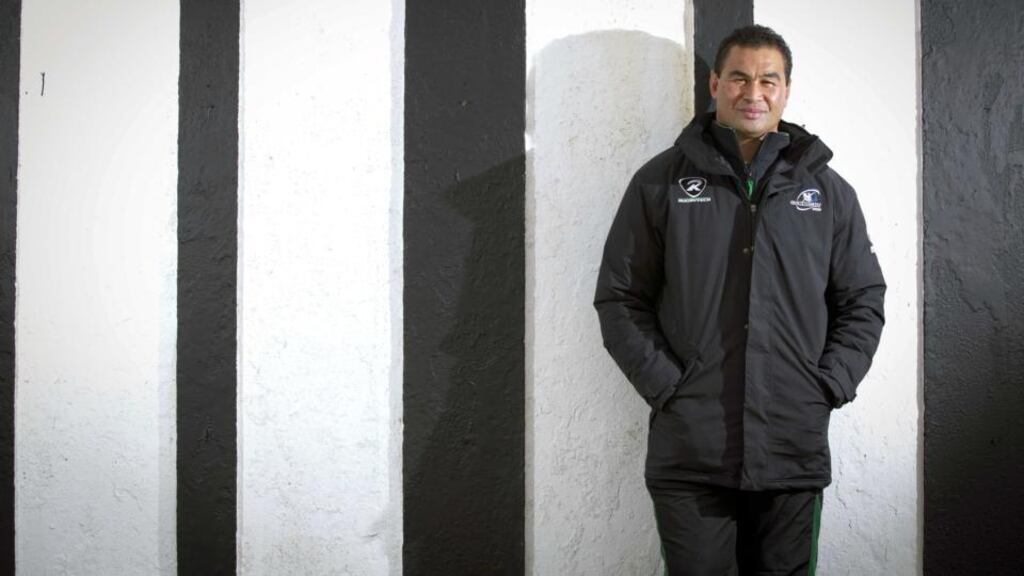Pat Lam had only just settled into life in Galway when he bumped into a few Samoans around town. He hadn't expected to find any compatriots other than Rodney Ah You and James So'oialo. "But then anywhere I have gone in the world, Samoans pop up," he grins. "They get around the place."
Lam is so immersed in European rugby right now that he doesn't have much time to think about the international game. He is still in training gear when he opens his office door in the Sportsground, trying to squeeze in a half hour of paperwork before a Sky television interview about Connacht's exceptional performance against Saracens and an upcoming visit to Zebre – in which they would go on to record their first Heineken Cup win for Lam.
But he agrees that he is looking forward to the visit of Samoa, all the more so because the international happens to coincide with a visit of his parents to Galway. "So we got tickets and it's great to be able to go." Lam's parents were among the generation of Samoans who moved en masse to New Zealand in the 1960s.
New Zealand system
It was redolent of the pattern of emigration which marked the relationship between Ireland and England but with none of the attendant antagonism between the two countries. All of Samoa's great rugby players came up through the New Zealand school and club system and it was rugby, he points out, which helped to establish Samoa in the eyes of most people.
When Lam is asked about the highlight of his sporting life, he quickly settles on the 1991 World Cup when he travelled with Western Samoa for what felt like a debut appearance on the world stage. "That tournament put Samoa on the map," he says. Four years earlier, the country had been snubbed when the IRB failed to extend an invitation to the inaugural World Cup, a slight felt all the more keenly as it took place in New Zealand.
Western Samoa had to qualify for the next competition and there was a big internal push to ensure the team made it. Domestic rugby was piecemeal but superb players like Steve Bachop and Frank Bunce had committed to the national team and they had an excellent coaching staff.
Prior to the World Cup, the only full tier international that the Samoans had ever played was against Wales. On October 6th, 1991, they performed their ritual Siva Tau in the Cardiff Arms Park and then produced one of the great shocks in world rugby by beating their hosts 16-13.
Just like that, the Samoans provided the jolt of unexpectedness and newness that the competition needed. They held Australia, the eventual winners, to three Michael Lynagh penalties in a 9-3 defeat before turning on the style with a 35-12 win over Argentina which set them up for a quarter-final against Scotland.
"People in Samoa were heading to the stadium at three in the morning to watch live broadcasts. You had 30,000 people turning up there. And we got images of that back in our hotel. And the hotel fax was getting non-stop messages. That really drove us on. That is when it felt as if there was a legitimate option to play for Samoa. Tours and invitations followed and the national team has just gotten stronger and stronger and in terms of professionalism, some of the Samoan boys in France and Europe are earning as much money as the All-Blacks.
Heart and spirit
"And we broke into a top six ranking not so long ago. The one thing you can't underestimate with Samoa is what they have here in Connacht too – that is heart and spirit. When the boys get together, it is special. In 1991 you had guys like Frank Bunce and Stephen Bachop – players in key positions who could direct things. We had good coaches and we surprised a lot of people." It ended with a 28-6 defeat against Scotland but afterwards, the Samoans gave a farewell lap.
Lam went on to play in the 1995 and 1999 tournaments for Samoa, finishing his international career by scoring a try against Wales. In the past decade, players like Jerry Collins, Tana Umaga and Kevin Mileamu emerged as totemic figures in All Blacks and world rugby. The peculiar thing is that there was never any moral obligation on players eligible to declare for their ancestral country to do so.
"There are probably more Polynesians in Auckland than there is in Polynesia itself. The drift to New Zealand was all based on work opportunity but then the kids went through the school system and people became integrated. But the awareness of roots stays strong. The thing about Samoa is that family is so important – you hear the rugby players call each other 'bro' a lot. It is about the extended family. And like the Irish, we had big families."
Raised the profile
"The guys like Tana who had big All Black careers just raised the profile of Samoan rugby. When New Zealand plays Tri Nations, they are Samoa's team. And those guys go back and do a lot of work on the island. They are heroes there. So if a Samoan does well in parliament or in law or whatever, it shows that you can come from this small island and achieve a lot. So there has been no antagonism."
In fact, it has now reached the point where players eligible for both countries are making a straight declaration for Samoa. Alapati Leuia did so and Lam’s cousin Jack, a flanker with Hurricanes, also opted for his grandparents’ country. “The relationship with New Zealand has just enhanced rugby in Samoa. The big problem for Samoa is that guys who play sevens for New Zealand are no longer eligible . . . it is a tough rule because sevens is a totally different game. But internationally, we have real stability now. There was a period when players were worrying about committing to internationals because they were afraid it might affect club contracts and that. So Regulation 9 [which stipulates players must be released for international duty] has really helped.”
Lam is looking forward to showing his parents around Galway even if he is still trying to get his head around the moodiness of the west of Ireland weather. His ancestral land is, he says cheerfully, a different postcard: sunshine and fantastic beaches. “But laid back like here and, as they say in Ireland, good craic.” He still goes back to Samoa when he can. “I’ve heaps of cousins. My grandfather was one of 23! So there are Lams everywhere.”















